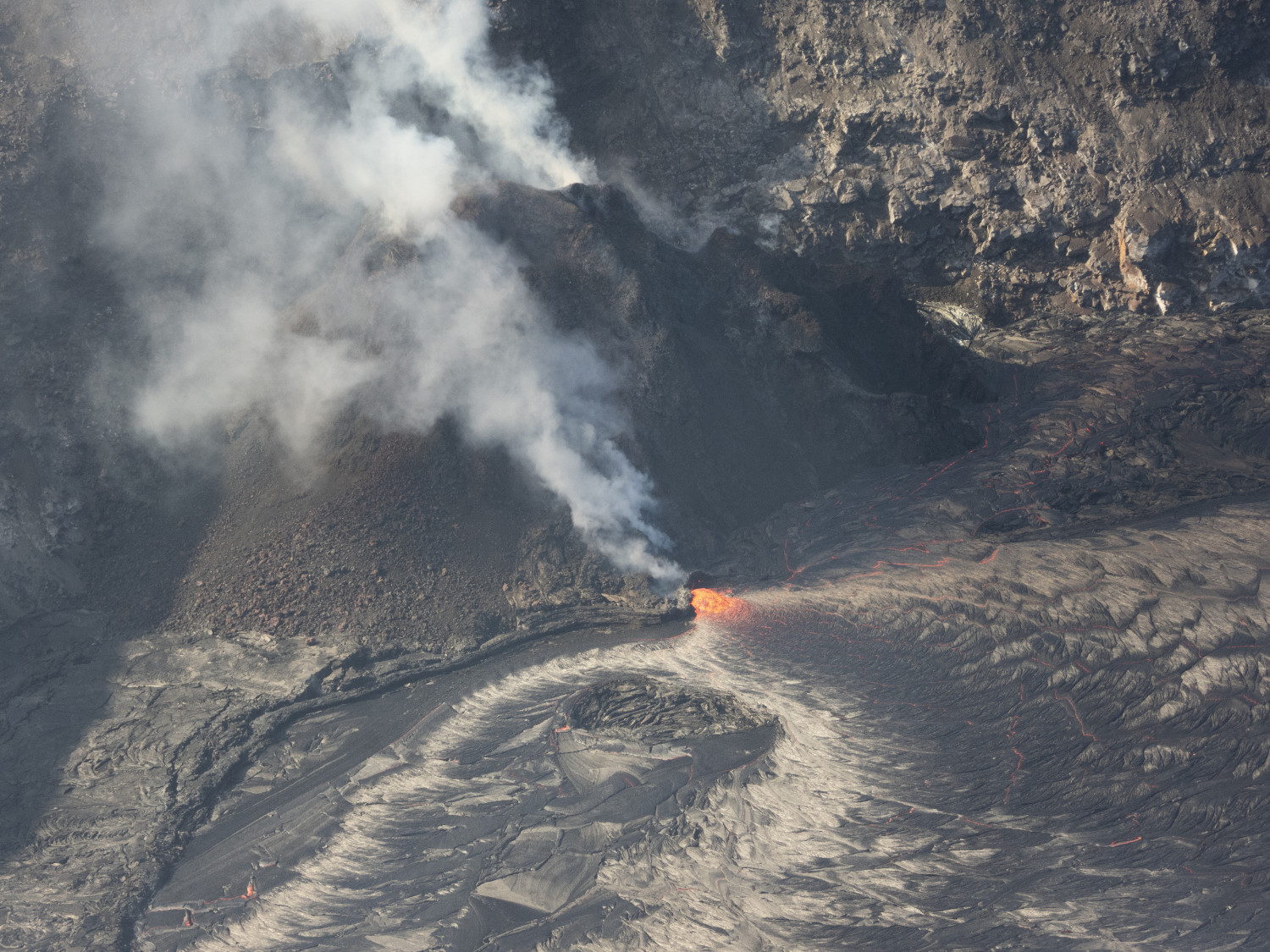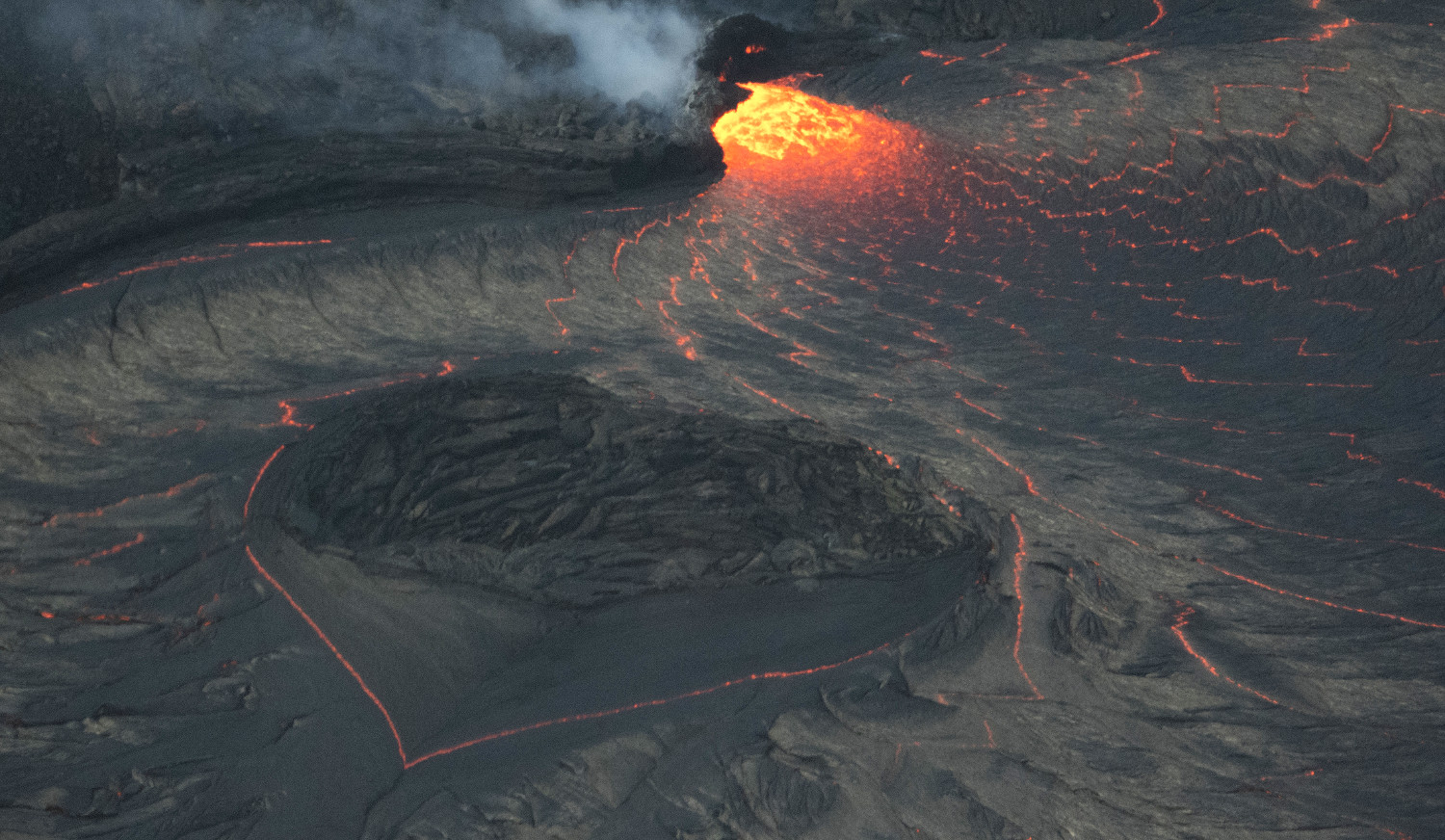
No major changes were observed at the lava lake in Halema‘uma‘u crater during the field visit to Kīlauea Volcano’s summit on Thursday, February 11. The western fissure, shown here, remained active with lava entering the lake at the normal inlet site. The inlet consisted of a small upwelling zone that was raised several meters (yards) above the surrounding lake surface. USGS photo by M. Patrick.
(BIVN) – Kīlauea volcano continues to erupt, and remains at an ORANGE / WATCH alert level. All activity is confined to the summit area, within Halemaʻumaʻu crater.
Monitors show continued inflation, which in recent weeks has correlated to increased vigor of the lava eruption at the active vent.
A few days before Valentine’s Day, USGS geologist Matt Patrick captured a photo showing a heart-shaped outline on the lava lake, created as lava flowed around a small island, south of the inlet zone.
UPDATE – (9 a.m.) – From the USGS Hawaiian Volcano Observatory on Sunday morning:
Activity Summary: Kīlauea Volcano is erupting. Lava activity is confined to Halemaʻumaʻu with lava erupting from a vent on the northwest side of the crater. As of the morning of February 14, the lava in the western, active portion of the lake in Halema‘uma‘u was about 216.5 m (711 ft) deep, with the eastern portion of the lava lake solidified at the surface. SO2 emission rates remain elevated.
Summit Observations: The most recent sulfur dioxide emission rate measurements from February 12 are about 1,100 t/d—lower than the emission rates from the pre-2018 lava lake (around 5,000 t/d). The summit tiltmeters show that the inflation of the last few days leveled off beginning yesterday afternoon. Seismicity remains elevated but stable, with elevated tremor and a few minor earthquakes.
East Rift Zone Observations: Geodetic monitors indicate that the upper portion of the East Rift Zone (between the summit and Puʻu ʻŌʻō) contracted while the summit deflated at the onset of this eruption. There is no seismic or deformation data to indicate that additional magma is currently moving into either of Kīlauea’s rift zones. SO2 and H2S emissions from Puʻu ʻŌʻō were below instrumental detection levels when measured on January 7.
Halemaʻumaʻu lava lake Observations: Lava from the west vent continues to supply the lava lake within Halema‘uma‘u crater.
The active western half of the lava lake was approximately 216.5 m (711 ft) deep today on February 14, 2021.
Yesterday morning, HVO geologists observed effusion continued at the western fissure, with a small upwelling fountain at the inlet site on the western lake margin. From this small upwelling, the lava rapidly developed a thin crust and flowed outwards towards the east. Over the past day, a few lava spillovers just north of the inlet site have flowed around the northwestern margin of the perched lake.
Active lava remained limited to the western side of the main island. The position of the main island has not changed; as measured on February 12, the south end of the island was 9 m (30 ft) above the lava lake surface, with the highest point at 21 m (69 ft) above the surface. All other islands remain stationary, frozen in the stagnant eastern portion of the lava lake.
Near-real time webcam views of the lava lake can be found here.
Hazard Analysis: High levels of volcanic gas, rockfalls, explosions, and volcanic glass particles are the primary hazards of concern regarding this new activity at Kīlauea’s summit. Large amounts of volcanic gas—primarily water vapor (H2O), carbon dioxide (CO2), and sulfur dioxide (SO2)—are continuously released during eruptions of Kīlauea Volcano. As SO2 is released from the summit during this new eruption, it will react in the atmosphere with oxygen, sunlight, moisture, and other gases and particles, and within hours to days, convert to fine particles. The particles scatter sunlight and cause the visible haze that has been observed downwind of Kīlauea, known as vog (volcanic smog), during previous summit eruptions. Vog creates the potential for airborne health hazards to residents and visitors, damages agricultural crops and other plants, and affects livestock operations. Rockfalls and minor explosions, such as the ones that occurred during the 2008–2018 lava lake eruption at Kīlauea summit, may occur suddenly and without warning. This underscores the extremely hazardous nature of Kīlauea caldera rim surrounding Halemaʻumaʻu crater, an area that has been closed to the public since late 2007. Pele’s hair and other lightweight volcanic glass fragments from the lava fountains within Halemaʻumaʻu will fall downwind of the fissure vents and lava lake, dusting the ground within a few hundred meters (yards) of the vent. High winds may waft lighter particles to greater distances. Residents are urged to minimize exposure to these volcanic particles, which can cause skin and eye irritation similar to volcanic ash.
Vog information can be found at vog.ivhhn.org.
Please see this Hawaii Volcanoes National Park Press Release “How to Safely View the New Eruption in Hawaiʻi Volcanoes National Park”.
The Hawaiian Volcano Observatory (HVO) continues to closely monitor Kīlauea’s seismicity, deformation, and gas emissions, and maintains visual surveillance of the summit and the East Rift Zone. HVO will continue to issue daily updates and additional messages as needed.


by Big Island Video News8:44 am
on at
STORY SUMMARY
HAWAIʻI VOLCANOES NATIONAL PARK - A few days before Valentine's Day, the USGS captured a photo showing a heart-shaped outline on the lava lake, created as lava flowed around a small island, south of the inlet zone.